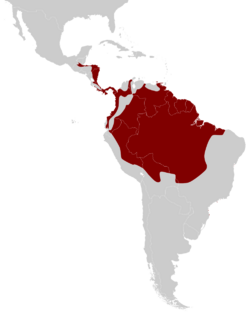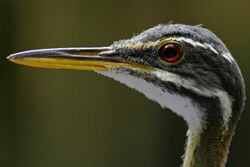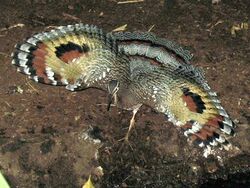Biology:Sunbittern
| Sunbittern | |
|---|---|

| |
| on Cristalino River Southern Amazon, Brazil | |
| Scientific classification | |
| Domain: | Eukaryota |
| Kingdom: | Animalia |
| Phylum: | Chordata |
| Class: | Aves |
| Order: | Eurypygiformes |
| Family: | Eurypygidae Selby, 1840 |
| Genus: | Eurypyga Illiger, 1811 |
| Species: | E. helias
|
| Binomial name | |
| Eurypyga helias (Pallas, 1781)
| |

| |
| Sunbittern range | |
| Synonyms[1] | |
|
Ardea helias Pallas, 1781 | |
The sunbittern (Eurypyga helias) is a bittern-like bird of tropical regions of the Americas, and the sole member of the family Eurypygidae (sometimes spelled Eurypigidae) and genus Eurypyga. It is found in Central and South America, and has three subspecies. The sunbittern shows both morphological and molecular similarities with the kagu (Rhynochetos jubatus) of New Caledonia, indicating a gondwanic origin, both species being placed in the clade Eurypygiformes.[2]
Taxonomy
The sunbittern is usually placed in the Gruiformes, but this was always considered preliminary. Altogether, the bird is most similar to another bird that was provisionally placed in the Gruiformes, the kagu (Rhynochetos jubatus).[3][4] Molecular studies seem to confirm that the kagu and sunbittern are each other's closest living relatives and have a similar wing display.[5][6] They are probably not Gruiformes (though the proposed Metaves are just as weakly supported).[7] Altogether, the two species seem to form a minor Gondwanan lineage which could also include the extinct adzebills and/or the mesites, and is of unclear relation to the Gruiformes proper. Notably, the kagu and mesites also have powder down.
Subspecies
The sunbittern was formerly treated as two species (E. helias and E. major), but now they are treated as a single species with considerable variation between the subspecies. The three subspecies are recognised on the basis of plumage characters and size. The three subspecies are allopatric.[2]
- E. h. helias (Pallas, 1781) – Amazonian sunbittern
- E. h. major Hartlaub, 1844 – northern sunbittern
- E. h. meridionalis Berlepsch & Stolzmann, 1902 – foothill sunbittern
Description
The bird has a generally subdued coloration, with fine linear patterns of black, grey and brown. Its remiges however have vividly colored middle webs, which with wings fully spread show bright eyespots in red, yellow, and black. These are shown to other sunbitterns in courtship and threat displays, or used to startle potential predators. Male and female adult sunbitterns can be differentiated by small differences in the feather patterns of the throat and head. Like some other birds, the sunbittern has powder down.
The sunbittern has a long and pointed bill that is black above, and a short hallux as in shorebirds and rails. In the South American subspecies found in lowlands east of the Andes, the upperparts are mainly brown, and the legs and lower mandible are orange-yellow. The two other subspecies are greyer above, and their legs and bill are sometimes redder.[2]
Distribution and habitat
The sunbittern's range extends from Guatemala to Brazil . The nominate race, E. h. helias, is found east of the Andes in lowland tropical South America, from the Orinoco basin, through the Amazon basin and Pantanal. The subspecies E. h. meridionalis, has a more restricted distribution, being found along the East Andean slope in south-central Peru, in the lower subtropical zone at altitudes of 800–1,830 m (2,620–6,000 ft). The final subspecies, E. h. major, is found at various altitudes ranging from southern Guatemala, through Central America and the Chocó to western Ecuador.[2] This subspecies may also be present in southern Mexico. It has been traditionally reported from the Atlantic slope of Chiapas, but no specimens are known and there have been no recent records.[8]
The species is found in the humid Neotropical forests, generally with an open understorey and near rivers, streams, ponds or lagoons.[2]
Behaviour and ecology

They are cryptic birds that display their large wings, that exhibits a pattern that resemble eyes, when they feel threatened.
Feeding
The sunbittern consumes a wide range of animal prey. Insects form an important part of the diet, with cockroaches, dragonfly larvae, files, katydids, water beetles and moths being taken. Other invertebrate prey includes crabs, spiders, shrimps and earthworms. They will also take vertebrate prey including fish, tadpoles, toads and frogs, eels and lizards.[2]
Sunbitterns are one of 12 species of birds in five families that have been described as fishing using baits or lures to attract prey to within striking distance. This type of behaviour falls within the common definition of tool use. In sunbitterns this behaviour has only been observed in captive birds so far.[9]
Breeding
File:Song of Eurypyga helias.ogg Sunbitterns start nesting in the early wet season and before it starts they make flight displays 10–15 m (33–49 ft) high in the forest canopy. They build open nests in trees, and lay two eggs with blotched markings. The young are precocial, but remain in the nest for several weeks after hatching.[2][10]
References
- ↑ "Eurypyga helias (Pallas, 1781)". GBIF—the Global Biodiversity Information Facility. https://www.gbif.org/species/2474332.
- ↑ 2.0 2.1 2.2 2.3 2.4 2.5 2.6 del Hoyo, J. Elliott, A. & Sargatal, J. (editors). (1996) Handbook of the Birds of the World. Volume 3: Hoatzin to Auks. Lynx Edicions. ISBN:84-87334-20-2
- ↑ Houde et al. (1997) Phylogeney and evolution of 12S rDNA in Gruiformes (Aves). In: Mindell, D. P. (ed.), Avian Molecular Evolution and Systematics. Academic Press, San Diego. Pp. 121–158.
- ↑ Oliveira, Edivaldo H. C. de; Ferguson-Smith, Malcolm A.; O´Brien, Patricia C. M.; Tagliarini, Marcella Mergulhão; Santos, Michelly da Silva dos; Monte, Amanda Almeida; Furo, Ivanete de Oliveira (2015-12-01). "Cytotaxonomy of Eurypyga helias (Gruiformes, Eurypygidae): First Karyotypic Description and Phylogenetic Proximity with Rynochetidae" (in en). PLOS One 10 (12): e0143982. doi:10.1371/journal.pone.0143982. ISSN 1932-6203. PMID 26624624. Bibcode: 2015PLoSO..1043982F.
- ↑ Fain & Houde (2004) Parallel radiations in the primary clades of birds . Evolution 58(11): 2558–2573.
- ↑ Ericson et al. (2006) Diversification of Neoaves: Integration of molecular sequence data and fossils. Biology Letters 2 (4): pp. 543–547
- ↑ Morgan-Richards et al. (2008) Bird evolution: testing the Metaves clade with six new mitochondrial genomes. BMC Evolutionary Biology 8 (20).
- ↑ Howell, Steve N. G. and Webb, Sophie (1995) A guide to the birds of Mexico and Northern Central America ISBN:0-19-854012-4
- ↑ Ruxton, Graeme D.; Hansell, Michael H. (January 2011). "Fishing with a Bait or Lure: A Brief Review of the Cognitive Issues". Ethology 117 (1): 1–9. doi:10.1111/j.1439-0310.2010.01848.x.
- ↑ Archibald, George W. (1991). Forshaw, Joseph. ed. Encyclopaedia of Animals: Birds. London: Merehurst Press. pp. 100. ISBN 978-1-85391-186-6.
External links
- BirdLife Species Factsheet
- Sunbittern videos, photos & sounds on the Internet Bird Collection
| Wikimedia Commons has media related to Eurypiga helias. |
Wikidata ☰ Q601107 entry





